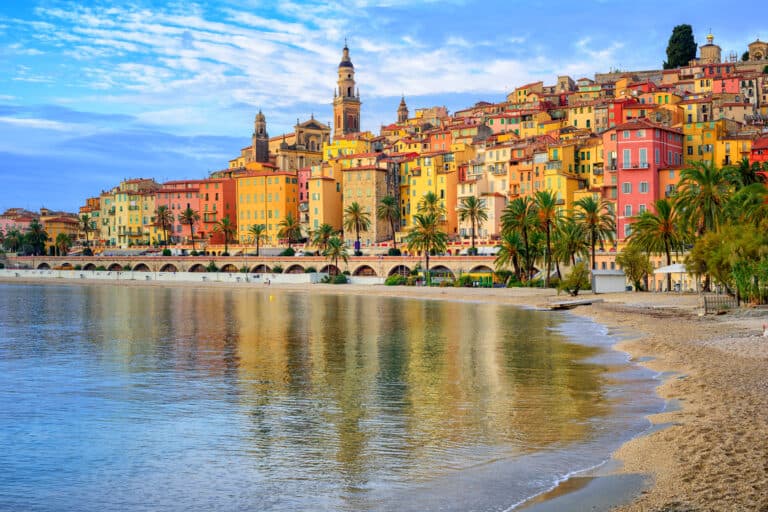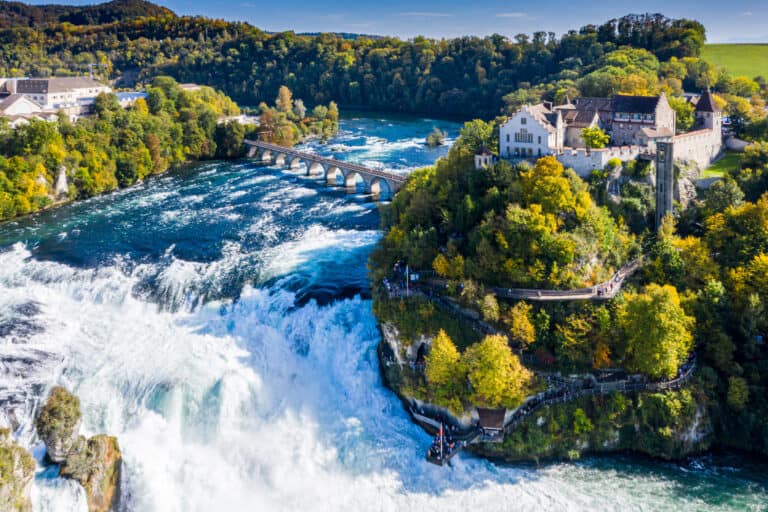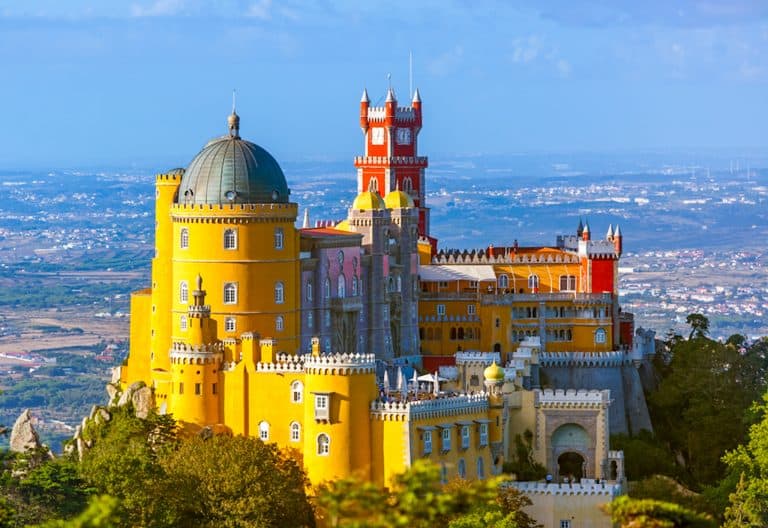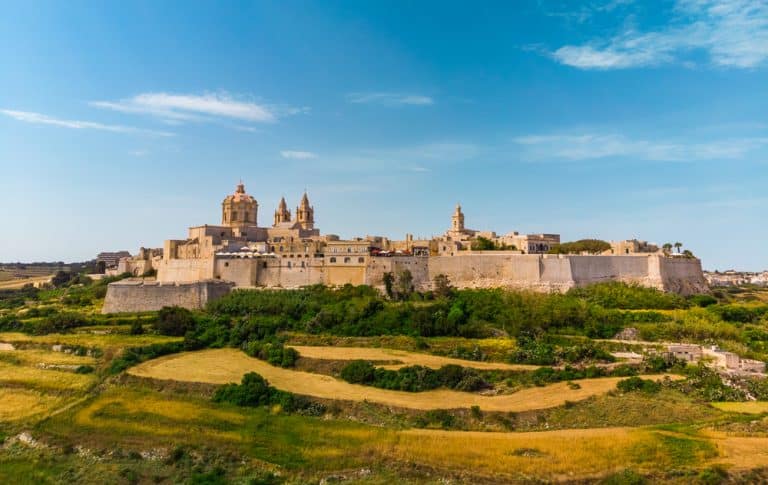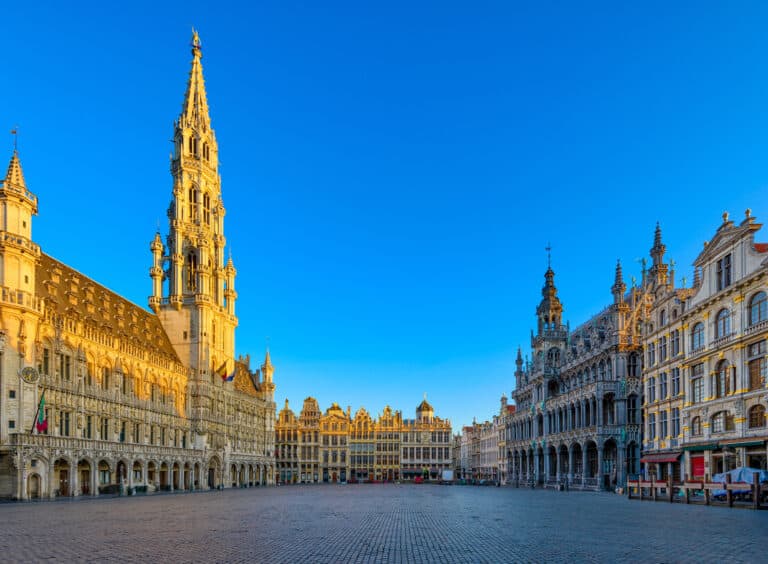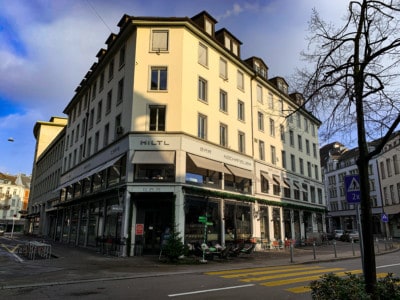One day in Ghent: 15 things to put on your itinerary

The Belgian city of Ghent can sometimes be overlooked as a tourist destination due to its close proximity to Bruges. But if you’re on a trip to Bruges or elsewhere in the area, it’s definitely worth spending one day in Ghent.
It’s a great city, with a historic centre containing sights that have been awarded UNESCO Heritage status. Because of these, it is a magnet for thousands of tourists every year.
About Ghent
Although it is not as ‘chocolate-boxy’ as Bruges, the much larger Ghent (Gent in Flemish) has many similarities with its more celebrated neighbour.
As with Bruges, you’ll find a wealth of eye-catching medieval architecture in its historic centre and many beautiful buildings. There’s a Belfry that has been designated a UNESCO World Heritage site, a picturesque river with boat tours, and a smattering of first-class museums.
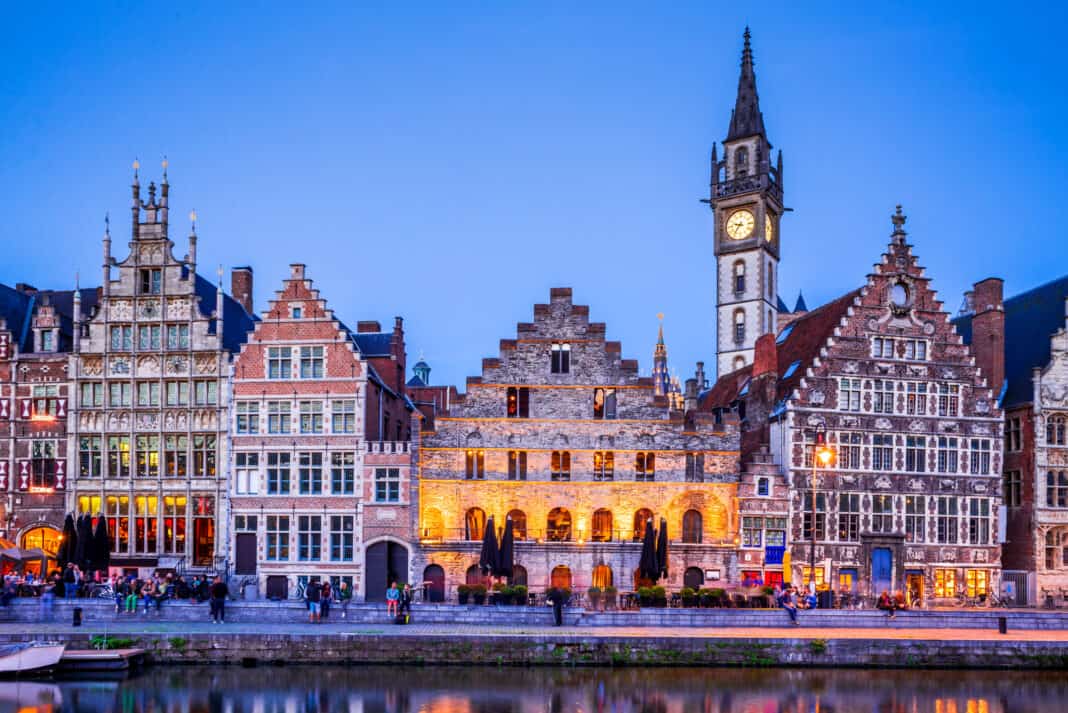
Unlike Bruges, however, Ghent is more of a working town. Being a university city, it also has a sizeable student population, which adds to its colour and vibrancy.
Also, because many visitors head straight to Bruges from Brussels – passing through Ghent on the train on the way – it also doesn’t suffer so much from overcrowding, especially at the height of the tourist season.
In its own right, Ghent is a fascinating, historic city. It offers a diverse range of attractions and is worth visiting.
Littered with many beautiful and historic buildings, some of which display stunning gothic architecture, you will probably come away wishing you had spent more than a day here.
Read on for more information on the best things to see and do with one day in Ghent and the main attractions to put on your itinerary.
This post contains affiliate links
The top things to do with one day in Ghent
One day in Ghent
– Take in the views from St. Michael’s Bridge
– See Graslei and Korenlei
– Climb the Belfry of Ghent
– Go into St. Bavo’s Cathedral
– Be wowed by the Adoration of the Mystic Lamb
– Take a look at St. Nicholas’ Church
– Explore the medieval Castle of the Counts
– Wander around the medieval district of Patershol
– Stroll up to the Old Begijnhof
– Have lunch at the Groentenmarkt
– Try some Belgian beer in Vrijdagmarkt
– See St. James’ Church and Ghent’s Town Hall
– View the street art in Graffiti Street
– Take a boat trip
– Visit a museum
Where is Ghent?
Located in the Flanders region of Belgium to the north of the country, Ghent has excellent transportation links. This is thanks in part to the fact that it has two train stations, as well as its position on the main railway line from Brussels to several destinations on the Belgian coast.
The city’s location is roughly halfway between Brussels and Bruges. This means it is ideal for a day trip if you are based in either of these two cities.
Brussels is around 30 minutes away by train, and Bruges is only about 20 minutes.
Having two train stations – the main one is Gent-Sint-Pieters station and the other is Gent-Dampoort – means you can travel around the Flanders region with ease. There are also frequent train services from both stations to notable cities like Antwerp, Leuven, and Mechelen.
Belgian is a small country, so it is also straightforward to take a day trip to Ghent from places further afield, as trains typically connect to the capital. Ghent’s proximity to Brussels and its central stations means you can get to this historic city very quickly.
How to get to Ghent
Most visitors to Ghent will probably arrive via the capital, Brussels. However, as noted above, it is easy to day trip from Bruges and other Belgian cities.
By train
If you are arriving from the UK by Eurostar, it’s a simple change of platforms at Brussels Midi station. You’ll then arrive at Gent-Sint-Pieters train station in around 30 minutes. The train ticket in October 2023 was 12 Euros for a single. For more information, click here.
As Ghent is located on the main railway line between Brussels and towns on the Belgian coast, you will benefit from regular, local train services from the Belgian capital and places like Bruges.
For those visitors that are arriving at Brussels International Airport, you can also catch a direct train to Ghent. The journey time varies, but the fastest trains are just under an hour.
By bus
Some visitors may choose to take the bus to Ghent from Brussels. Again, there are regular services.
However, the journey time is longer than travelling by train: around an hour.
By day tour
Alternatively, if you’re staying elsewhere in Belgium, you could book a day tour to take you to the city.
Or you may want to visit Ghent and other places as well.
If so, this tour takes you from Brussels to both Ghent and Bruges, giving you two hours in each and an optional boat ride. This would give you the chance to compare and contrast the two cities!
And this tour combines Ghent with a visit to Antwerp.
Getting into the city centre
If you do get the train from Brussels, you may arrive at the smaller Dampoort station. This is located much closer to Ghent’s historic old town than the main Sint-Pieters train station.
Should you arrive at Sint-Pieters train station, it is a fairly long walk into the historic centre. Fortunately, right outside the station, you’ll find a tram station where three routes pass through – numbers 1, 2, and 4.
Tram routes 1 and 2 both take you right into the historic centre. However, number 1 is the better of the two as it takes a more direct route.
Just make sure you take the tram in the direction of Evergem-Wondelgem. The tram in the opposite direction to Gent Flanders Expo will take you away from the city centre.
You can pay the 2.50 euro fare on the tram with your contactless bank card. It’s worth noting here that you can also purchase a De Lijn ticket (costing 2.50 euros) that allows you to use both buses and trams and is valid for 60 minutes. You can also purchase a day pass for 7.50 euros.
How to get around Ghent
Ghent is a fairly large sprawling city, and as noted above, it is both a major centre for employment as well as home to one of Belgium’s major universities.
For this reason, you’ll find Ghent has a different feel depending on where you’re exploring in this fascinating city. Some of it is quite industrial, but don’t let that put you off: this just adds to Ghent’s character.
However, with just one day in Ghent, you’ll probably want to head straight to the historic centre (old town). This is where you’ll find the main tourist attractions and the major landmarks.
Once you arrive in Ghent’s old town, it’s easy to get around on foot. All of the sights you’ll want to see are close to each other.
Depending on the weather and what you want to see and do, you might also find that the best way to get around is the hop-on hop-off water tramway.
I did this and found it was a really helpful way to get between some of the sights. Further down, I’ve gone into more detail about what this option offers.
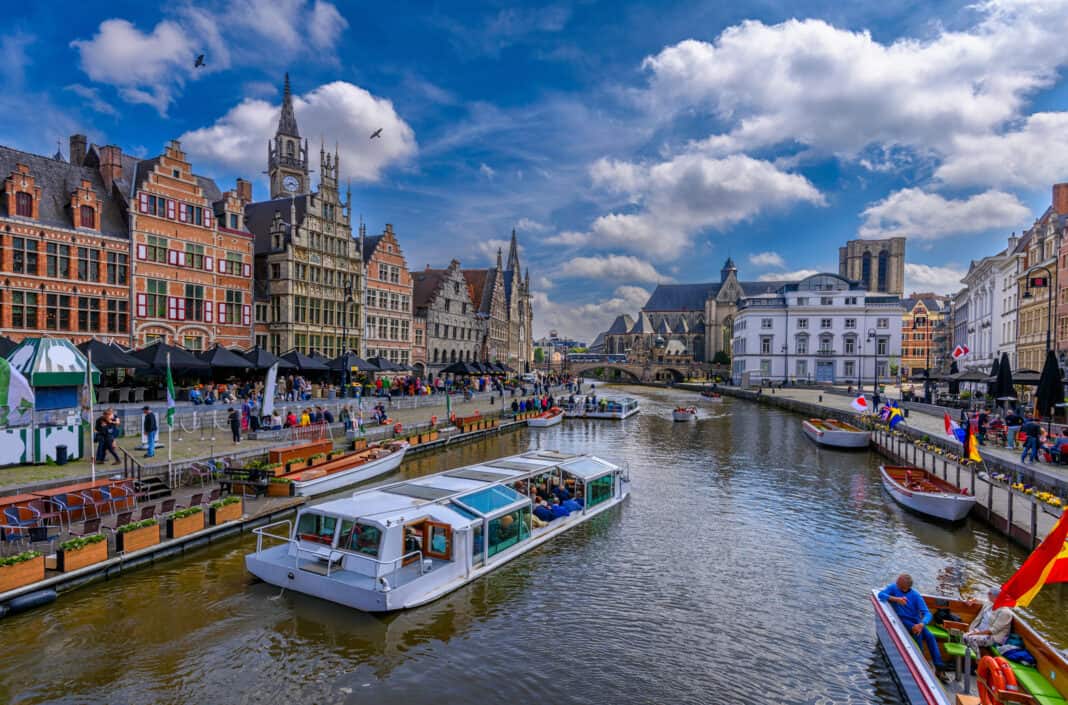
Walking tours
Another option – especially if you want to pack a lot in – is to do a walking tour. Like many Belgian cities, Ghent is a perfect place to explore on foot.
This is a guided tour with a local guide that takes you through the main sights in the city. You also get a boat ride in the second half of the tour.
There is also this tour which combines a walking tour with the chance to try some of the famous Belgian chocolate!
To take a look at other walking tours in Ghent, click here.
One day in Ghent
Ghent has something to offer everyone. Obviously, it depends on what you want to see and do, but in my opinion, there are some top things you should put on your Ghent itinerary.
What I have listed below are the leading attractions that you should try and see if you have time.
Many are located in Ghent’s historic centre, which covers a really walkable area. Most of the top attractions are situated around just a handful of squares or the two facing quays separated by the River Leie (Lys in French).
I’ve ordered them below in terms of where they are located in the city. You may not have time to do them all, but this list will make it easier for you to organise your time during one day in Ghent and to choose what you want to focus on.
St Michael’s Bridge
If you take the number 1 tram from the station to the historic centre, get off at Korenmarkt and head for St. Michael’s bridge, a five-minute walk away. This is probably a good place to start your one day in Ghent.

This arched stone bridge crosses the River Leie. It is perhaps the most popular spot from which visitors to Ghent stand to photograph the city’s spectacular skyline.
From St Michael’s Bridge, you are afforded fabulous views of the row of fine medieval buildings with their distinctive step-gabled roofs. These stretch alongside the Grasei quay on the opposite side of the river from Korenlei.
Looking over to the Graslei from the bridge and starting from the left, you’ll notice a beautiful clock tower rising above one of the grand buildings described above. Surprisingly, this is part of the De Post shopping centre that opens onto Korenmarkt on the other side.
However, the main attraction for visitors is the three magnificent (and towering) landmarks that stand in a line to the clock tower’s right.
These are from left to right: Saint Nicholas’ Church, the Belfry of Ghent and Saint Bavo’s Cathedral. At night, the bridge view looking from the clock tower over to St Bavo’s Cathedral is incredible.

If you have time while standing on St Michael’s Bridge, you may want to pop into the stunning gothic church that bears the same name as the bridge. This stands on the same side as Korenlei and contains work by Flemish artist Anthony Van Dyck.
Korenlei and Graslei
These two quays face each other across the River Leie and are popular with tourists and locals alike as spots to sit and relax when the weather is good.

The map I picked up explains that when Flanders became a major hub for international trade in the 11th century, it was right here on both sides of the river where goods were loaded and offloaded.
Today, the area is filled with tourist boats. Together with St Michael’s Bridge, both are popular spots to take photos. From the Korenlei side, in particular, you are spoilt for views.
The Belfry of Ghent
Ghent Belfry (the Belfort) in Ghent is undoubtedly one of the city’s main highlights and is a UNESCO World Heritage Site. Its 91 metre medieval tower is topped with a dragon, which is said to be the city’s symbol.

The Cloth Hall
After paying the entrance fee for the Belfry (when I visited in October 2023, it cost 11 euros to enter the building), you immediately step into the historic Cloth Hall (Lakenhalle). This is a large, spacious room with eye-catching black and white flooring.
The Belfry was originally constructed as a free-standing building, with work on it starting in 1313. It remained free-standing until the early 15th century when the Cloth Hall was built against it in 1425.
Information inside says the cloth industry in Belgium was already on the wane when building work began. The building therefore remained incomplete until the 20th century.
Climbing the belfry tower
After marvelling at the Cloth Hall, you need to climb down some steps at the side to an adjacent basement level to begin your climb up to the bell tower.
It can be very easy to miss, but at this level, you’ll see a black sign with white writing that advises you to take the lift up and the stairs down. The reason for this advice becomes apparent further up (this is essentially a one-way system that is encouraged for safety reasons).
It is possible to walk up to the middle section if you want – but definitely take the lift further up from there.
The Watchmen’s Room
The one-way lift takes visitors from the basement level up to the viewing level. There is one stop to pick up any visitors that have climbed up to the middle section.
Here there is the Watchmen’s Room, where you’ll find a wealth of information about the Belfry and the Cloth Hall. For instance, I read that the first wooden clock mechanism was installed here in the late 14th century.
Inside this room, it is hard to miss the large model of a dragon. There is also another dragon on top of the belfry that was placed there in 1980.
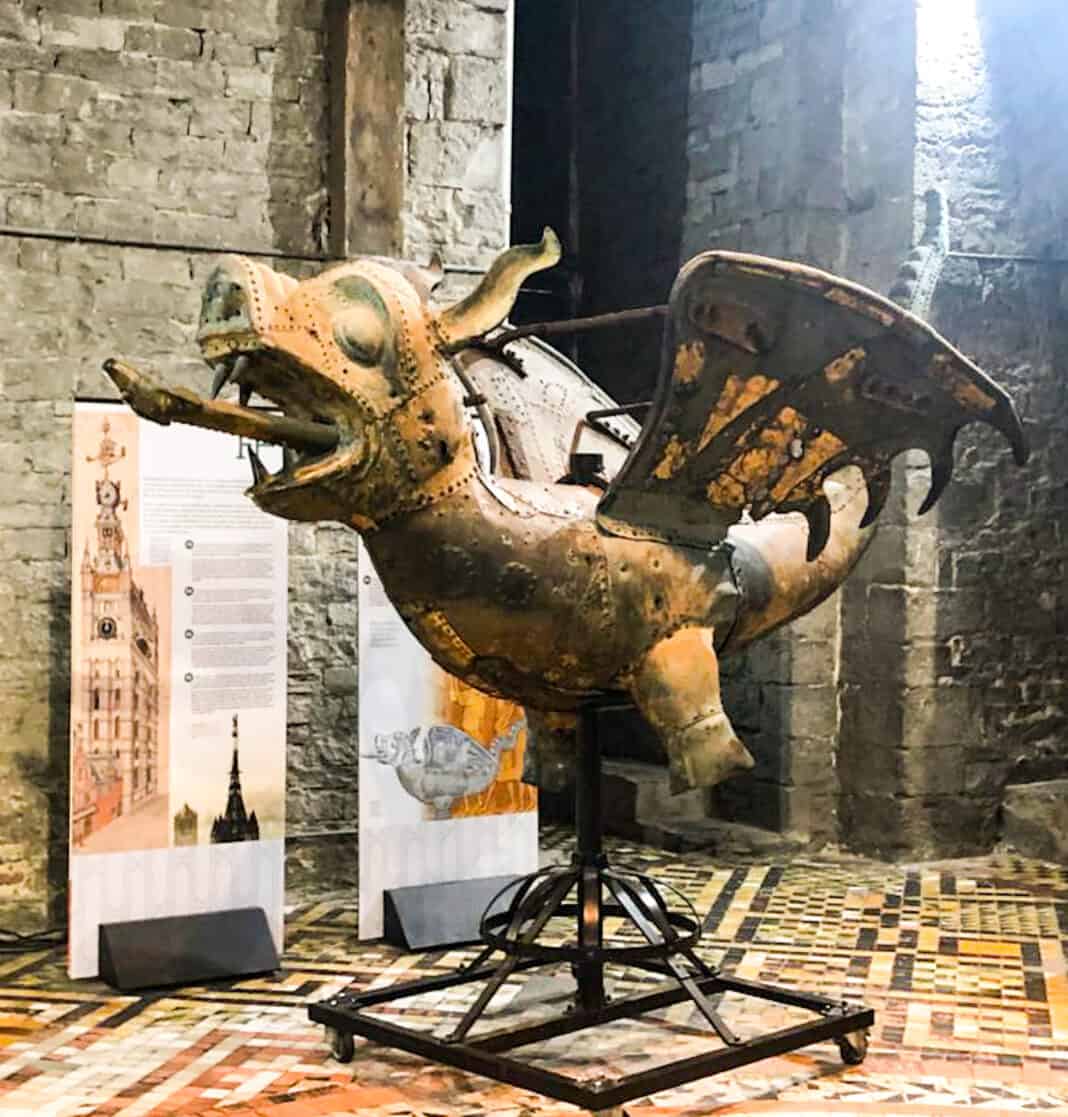
The top of the Belfry
The highlight of visiting the Belfry of Ghent is, without doubt, the incredible (albeit hair-raising) views you get from each of the four sides of its tower walls at the top.
When the lift doors open at the top, you walk out onto the first side of the tower. You then have to make your way around each of the four sides of the building in an anticlockwise direction. The one-way system is encouraged as the sides of the tower walls are very narrow, which means it can be difficult to pass other people.
For those that don’t like heights, each corner is entirely enclosed. They’re also quite spacious if you want to wait for others to take photos before proceeding.
However, you are not entirely enclosed on the walkways between the corners, and it is possible to lean slightly forward through the edge of the tower walls to look down. For this reason, people with a fear of heights might find this quite a nervy experience.
If you do brave the top of the tower, the views are incredible. You can see right across the historic centre of Ghent and its main landmarks.
It’s definitely something to put on your list for one day in Ghent.

At the end, you descend down a very tight and quite steep staircase, which winds its way around in a circle back to the basement level. The descent down takes in more than 300 steps and takes you through very narrow and steep sections.
Note it is difficult to get the lift back down because of the one-way system at the top. So climbing the Belfry may not be something that everyone wants to do.
St. Bavo’s Cathedral
One of the three towering landmarks that stand in a line – the other two being the Belfry of Ghent and St Nicholas’ Church – is St Bavo’s Cathedral. This is the oldest parish church in the city and faces the Belfry across the picturesque square, Sint-Baafsplein.
Dating from the 10th century, it is notable for its commanding tower.
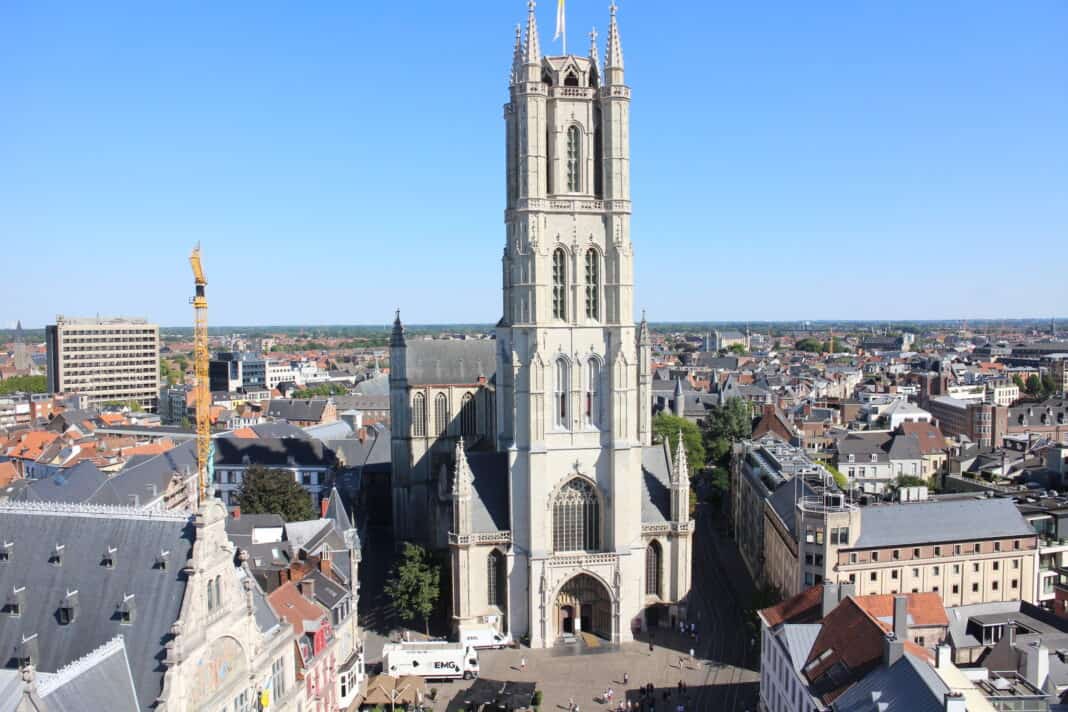
The cathedral is a magnificent building inside with some absolutely stunning stained glass windows.
However, there is one specific reason many visitors come to this cathedral: that is to see one of the world’s most celebrated artworks – the Adoration of the Mystic Lamb/Ghent Altarpiece – an early oil painting created by the Van Eyck brothers.
The Adoration of the Mystic Lamb
Although you can enter the cathedral for free, there is an extra cost to see this.
It is worth the cost as there are also some other fabulous paintings inside, including one by Reubens, as soon as you enter the paid section.
You get a small brochure when you buy your ticket. This gives you some handy information about the Lamb of God, as it is also known.
As I discovered, the altarpiece was inaugurated in 1432 and comprises 20 panels. One of these (‘The Just Judges’) is a recent copy, as the original went missing (there is a fascinating story behind this that you can read about).
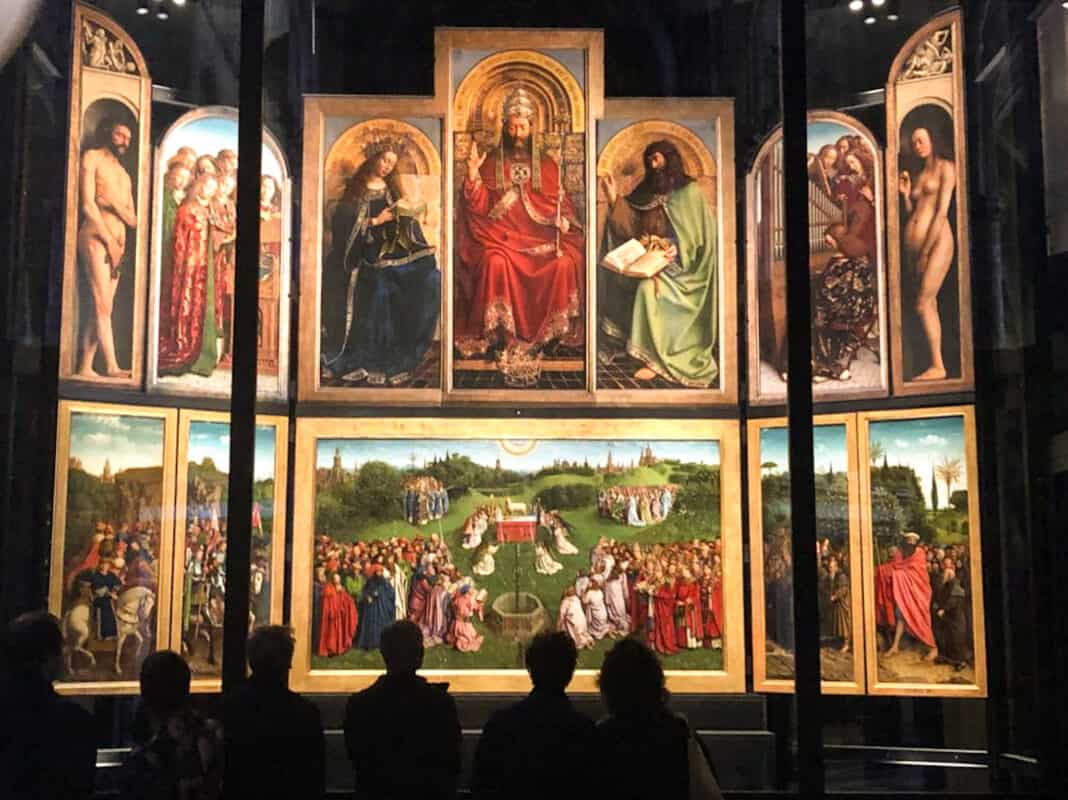
Combined, these panels measure 3.4 metres in height and 4.4 metres in width. The brochure tells you all you need to know about each of them. It is a stunning piece of work, and the intricate detail is mind-blowing.
St Nicholas’ Church
Standing over the Korenmarkt (one of the most impressive squares in Ghent) and facing the De Post shopping centre, St Nicholas’ Church is the first you come to of the three landmarks you see from St Michael’s Bridge.
The church was designed in the Scheldt Gothic style.
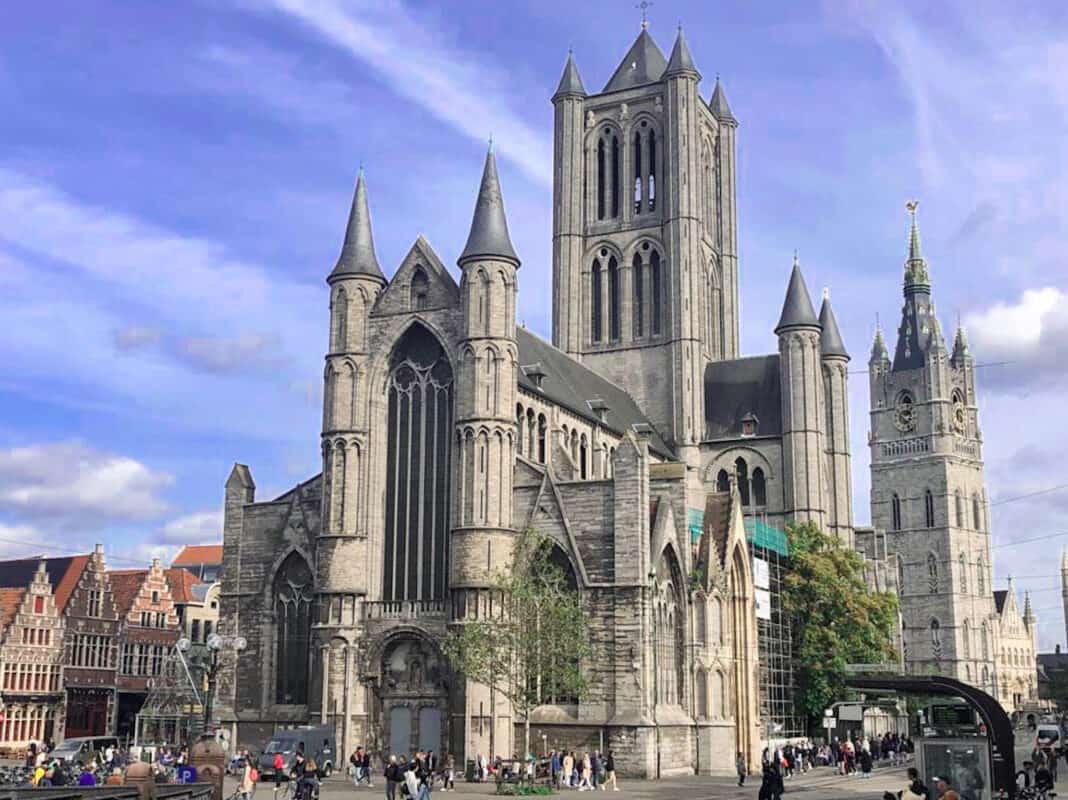
Gravensteen Castle
Also known as the Castle of the Counts, this unique landmark, dating from the 12th century, was something of a surprise when I visited Ghent. But it is worth visiting.
Less incongruous than Windsor Castle feels towering over Windsor’s modern town centre in England, I still thought it slightly odd to find a medieval castle standing right in the city centre.
The fact modern trams glide along the front and side of the castle only reinforces this juxtaposition between the modern and the ancient.

Whatever my initial thoughts, you’ll have a great time exploring this top attraction. However, this may not be a sensible option for anyone with mobility issues as it will require you to climb up and down many steps, some of which don’t have guard rails.
Inside the castle
Once you’ve passed through Gravensteen Castle’s entrance gate and bought your ticket – I paid 13 euros in October 2023 – you’ll need to pick up your audio guide.
I have to admit that I sometimes don’t bother with the guides, but I would recommend you do here – it’s both extremely informative and entertainingly funny in parts.
As you wander through the castle grounds, the different rooms inside, and the battlements, there are numbered spots corresponding with the numbers on the audio guide. Some of the commentary can be a bit long-winded but it’s worth persevering as you learn some really interesting facts about the castle’s owner and its history.
Apparently, in the late 12th century, Philip of Alsace chose to build a formidable castle next to the River Lieve so that he could look down over the city’s inhabitants from the castle keep.
Philip later died during one of the Crusades to the Holy Land, and you learn about his life and also about some of the gruesome events that took place here.
The highlight for me was wandering around the castle’s battlements. From here, there are viewpoints from which you can look out over Ghent’s skyline and marvel at the historic centre.
Patershol
The castle is literally a stone’s throw from the Information Centre in the old fish market (Vismarkt). It faces a pretty square called Veerle Plein, with a few bars scattered around it.
There are some interesting sights located immediately around the castle and the square. Notably, there is Patershol, which is an attractively preserved medieval district that features narrow and cobblestone streets.
There are some great little restaurants here. It’s also supposed to be really atmospheric at night if you are in Ghent late and fancy exploring then.
At one of the entrances to the Patershol area, on a waterfront street called the Kraanlei, you’ll find a museum dedicated to everyday life in Ghent. With artefacts spanning from the 18th century to the modern day, this is the House of Alijn (Huis van Alijn).
The Old Begijnhof
Not that far away from Gravensteen Castle, you’ll also find the Old Beguinage Saint Elizabeth. It’s only about a ten-minute walk away. It is really picturesque, with colourful houses and an impressive church.

It’s worth noting that there is also another beguinage in the city – the Small Beguinage, Our Lady ter Hoyen. This is located on the eastern side of Ghent. It can be reached with tram numbers 2 and 4 if this interests you.
Known as OLV Ter Hoyen, the information panel at its entrance revealed that the small Beginjhof, together with another 12 Flemish Beginjhofs (or Beguinages), was added to the UNESCO World Heritage list in 1998.
There are also beginjhofs in Bruges, Mechelen, and Leuven.
Lunch or dinner at the Groentenmarkt
If you walk over the bridge near Veerle Plein – this bridge is the one the trams cross over – you will come to the Groentenmarkt.
This picturesque square is an ideal place to grab something to eat, as there are quite a few food outlets here. As you cross the bridge, you’ll also see the Great Butchers’ Hall to your right, where meat was once sold.
I also discovered an excellent waterfront pub/eatery called Het Waterhuis aan de Bierkant, where I stopped to try some Belgian beer. I was recommended a great local beer called Wit Gruut, which comes from a brewery located not far from the pub.
Vrijdagmarkt and around
This humungous square is on the same side of the River Leie as the Groentenmarkt and a short five-minute walk away.
There is a Friday market here (hence the name of the square), and it’s impossible to miss the huge statue right in the middle. This is of Jacob Van Artevelde, who was a local hero for standing up to the French.
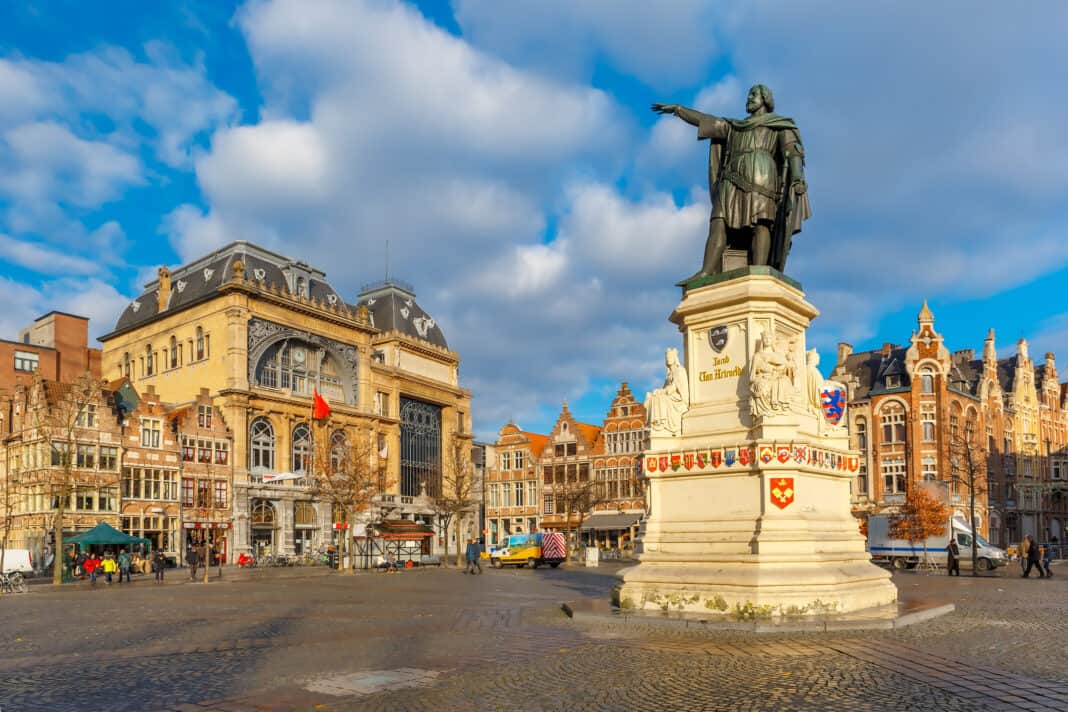
If you want to try out more Belgian beers, there is an excellent pub here called Dulle Griet. This is apparently named after the huge cannon you’ll see close to the River Leie.
The pub is a popular spot with locals and tourists alike, with an extensive beer menu. Just be careful how many you drink, as the beers can have a very strong alcohol content.
A very short walk from Vrijdagmarkt, you will see the distinctive spire of Sint-Jakobskerk (St James’ Church). This attractive building is apparently a stop for pilgrims on their way to Santiago De Compostela in Spain.
You can then walk back to the Belfry of Ghent via Belfortstraat and see Ghent’s Town Hall (Stadhuis). This comprises a mix of architectural styles – late Gothic and Renaissance period.
After exploring the Vrijdagmarkt, you can then walk for another five minutes down Hoogpoort to one of the entrances to Ghent’s Graffiti Street.
Graffiti Street (Werregarenstraatje)
One thing you don’t expect to see in Ghent is a street (more of an alleyway, and a gritty one at that) dedicated to graffiti with contributions from local artists.
When you walk down this alley, which is quite easy to miss if you don’t know where to look, the standard of graffiti is quite incredible.
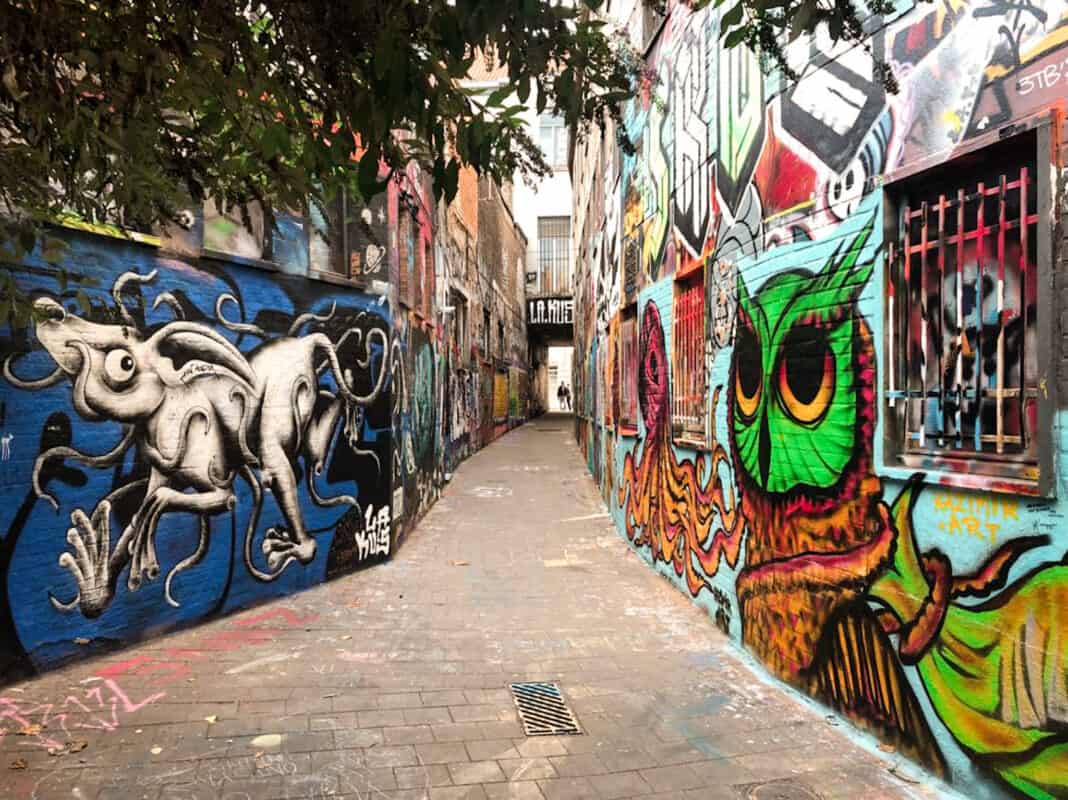
If you are in this area on your one day in Ghent, definitely set aside a bit of time to walk down it and marvel at the eye-catching street art sprawled across every inch of wall.
Boat trips
The water tram
A great way to get around and see the main sights is by boat.
When I visited in October, I was really lucky with the weather, so I did use the hop-on hop-off water tram service mentioned above. I got on at the stop at Kraanlei, literally a two-minute walk from Veerle Plein and Gravensteen Castle.
Starting at 11 am, the open boat operates every 90 minutes until 6.30 pm. It stops at six points where you can disembark and explore the nearby sights.
I picked up the 12.30 service and chose to stay on for the entire journey. I thought it was well worth the cost of the ticket.
On the boat
On the boat ride, you hear fascinating information about the city. When you get on, the boat driver asks what common languages people speak and starts a pre-recorded audio guide. They also provide various snippets of information that is not on these audio guides at certain points.
For example, there is a point where the Scheldt and Leie (Lys) rivers merge. Here, the boat driver pointed up to two statues on the balconies of residents’ flats on facing riverbanks.
One depicts a male diving into the water and the other a female. Apparently, the Scheldt represents the ‘burly’ man, and the Leis (Lys) represents the ‘sensual’ woman.
Also, you get some amazing and unrivalled views of Ghent’s historic landmarks from the seat of the boat, particularly around Graslei and Korenlei.
On the service, you’ll pass the old courthouse and the eye-catching De Krook, which houses the municipal library. This modern design is not to everyone’s tastes but it apparently bagged the designers the ‘Nobel Prize for Architecture’.
On the tour, you also get to go under a tunnel at one point. This emerges by the intriguingly named Castle of Gerald the Devil. The castle, which dates from the 13th century, was built to guard the Portus Ganda port.
You can get tickets for the water tram here.
Boat tours
If you don’t want to take advantage of the hop-on hop-off service, there are other boat tour options. These allow you to stay on the boat and admire Ghent as you navigate the city’s waterways.
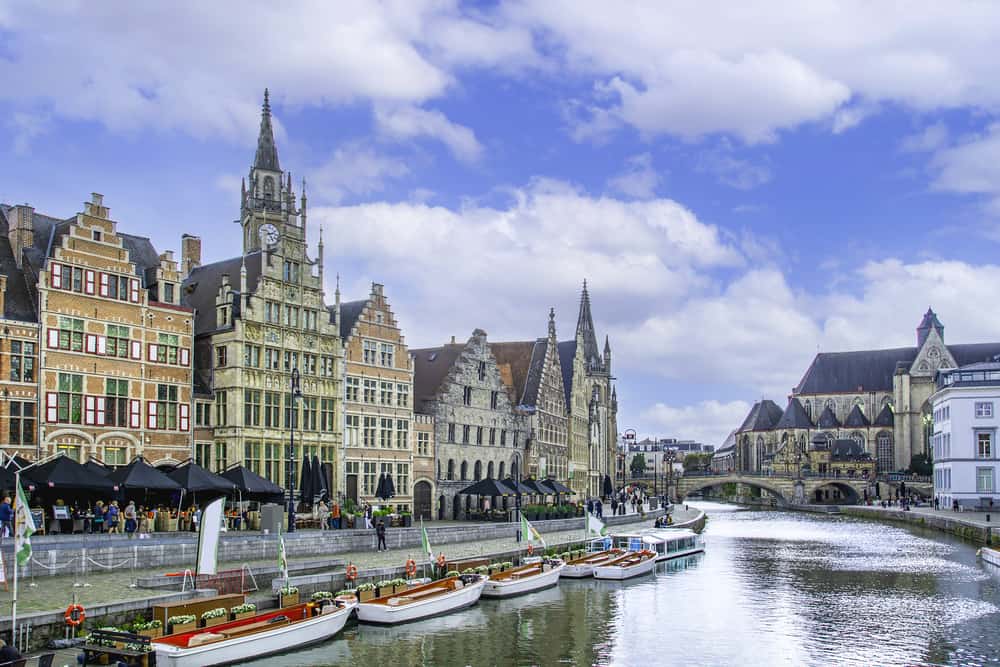
This tour is a guided trip by boat through the old medieval centre of the city. You get a 50-minute tour of the main attractions. The tour runs year-round.
Or if you are particularly pushed for time on your one day in Ghent, this tour is slightly shorter (40 minutes).
Visit a museum
The city has a number of museums you can visit. However, you do need to consider that some of these are not centrally located in the old town area.
In the University Quarter and Citadel Park to the south of the central attractions, you’ll find the following art museums near each other: MSK (The Museum of Fine Arts Ghent) and S.M.A.K (Municipal Museum of Contemporary Art).
GUM (Ghent University Museum), a science museum, is a short walk away. This is near to the Ghent University Botanical Garden.
STAM, the Ghent City Museum, is also not far away and is within walking distance.
As these are very near to each other and a little away from the medieval centre, you could always visit a couple at the same time. Or, as they are near Gent-Sint-Pieters train station, you could stop at one en route to the centre.
The best time to visit Ghent
Ghent is a city for all seasons. It has a fairly temperate climate with winters that rarely go into minus figures and summers that rarely go beyond the mid-20s in Celsius.
However, if you want to do a boat tour, you might prefer to visit in the spring, summer, or early autumn when it is warm enough to explore the city’s waterways and the weather is more likely to be favourable. Many boats are open, although some are covered.
Having said that, the city has a lot of really excellent museums and many historic landmarks where you will spend most of your time inside. So it doesn’t matter if you arrive and the weather isn’t as good as you hoped.
The only consideration you’ll need to take into account is the opening hours for each attraction. Check ahead, and if there is a particular museum you want to visit, make sure that it is open that day.
As explained earlier, Ghent doesn’t experience the same level of tourist numbers that Bruges does, particularly at the height of the season.
Also, because it’s much larger and many of its top attractions are arguably a bit more spaced out than they are in Bruges, the city can accommodate a larger footfall.
That means you can visit year-round without having to factor in how busy it will be (in the same way that you might want to do with, say, Bruges).
One day in Ghent
I hope you enjoy your Ghent day trip.
However, in addition to spending one day in Ghent, you should also check out some other fascinating places and put these on your Belgium itinerary. These include:
By Nick Warburton, with Emma Marshall

